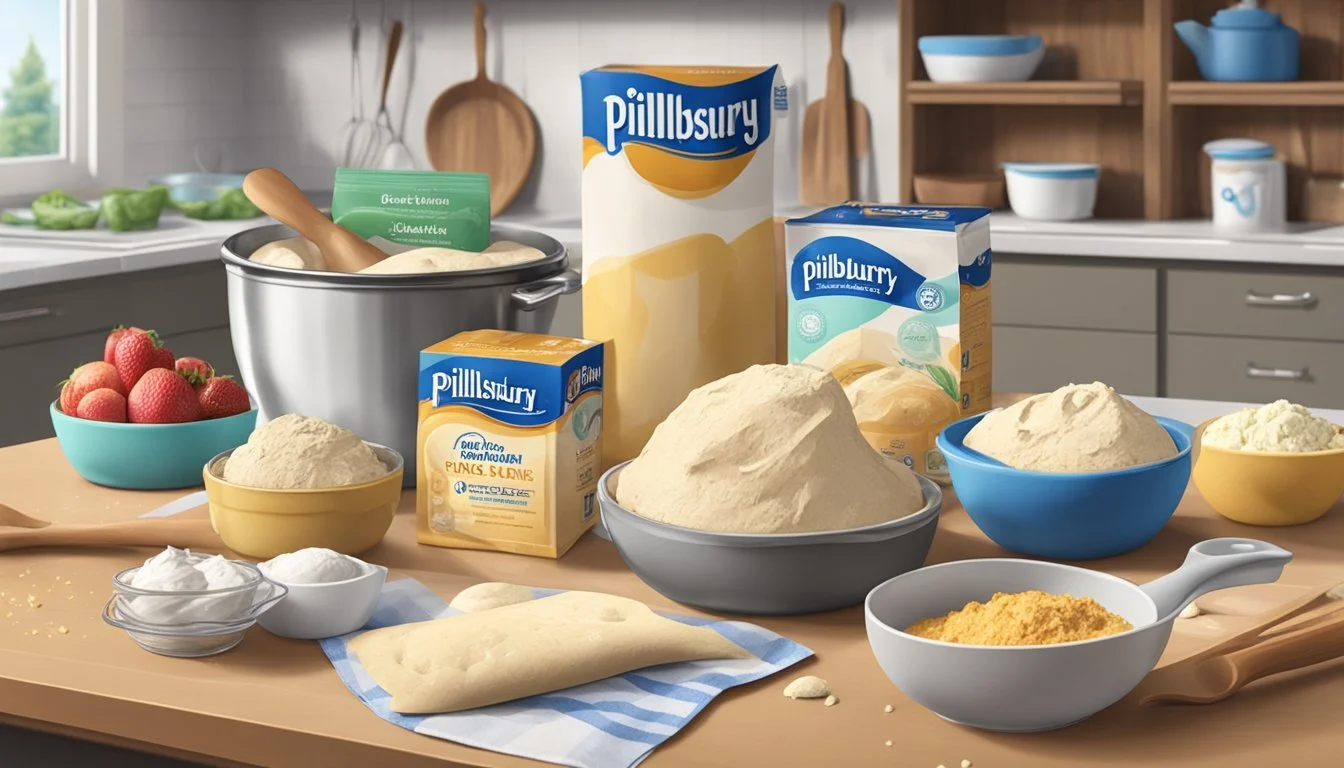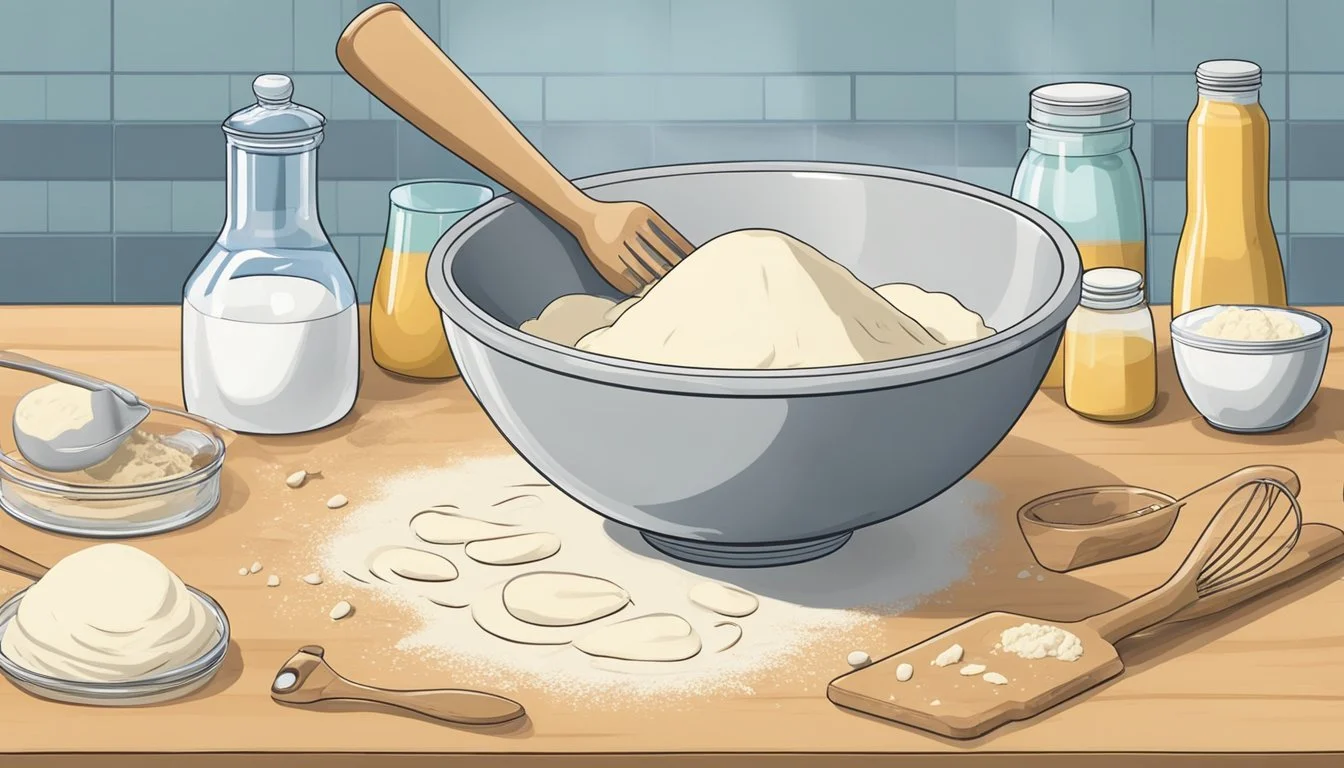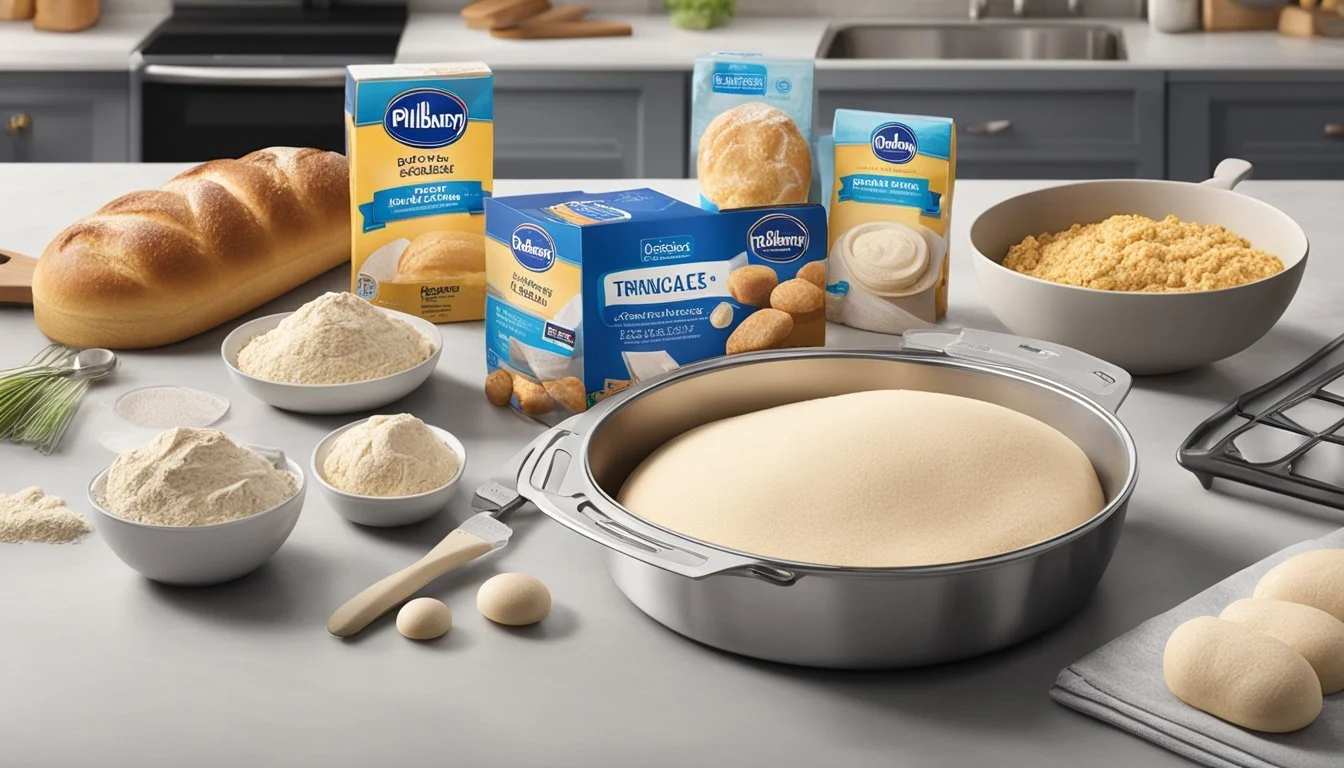How to Cook with Pillsbury Dough
Mastering Versatile Baking Techniques
Pillsbury dough is a staple ingredient that has revolutionized home baking, offering a quick and reliable solution for both novice and experienced bakers. This refrigerated dough comes in various forms, including biscuit, crescent roll, and pie crust, and is celebrated for its versatility. The ease of use propels culinary creativity, allowing cooks to craft everything from appetizers to desserts without the time investment of making dough from scratch.
In the realm of savory dishes, one can transform simple Pillsbury crescent roll dough into impressive creations like a chicken enchilada crescent wreath, adding an eye-catching centerpiece to any meal. For sweet treat enthusiasts, Pillsbury dough can be elevated by incorporating simple twists, such as pouring heavy cream over unbaked cinnamon rolls for added richness or using a chilled dough sheet for easy-to-make, gooey cinnamon rolls that come out perfectly every time.
The approach to utilizing Pillsbury dough is simple: one must respect the properties of the dough and follow the basic techniques of baking. By doing so, the dough's potential is fully realized—whether it's being used to create biscuit bites sprinkled with cinnamon sugar, or delicate turnovers brushed with a sugar-cinnamon mixture. It's a matter of combining the convenience of ready-made dough with the bakers' own creativity to produce delectable results.
Getting Started with Pillsbury Dough
When embarking on the journey of baking with Pillsbury dough, one should have a clear understanding of the types of dough available, the kitchen tools required, and the steps necessary to prepare for baking. Ensuring these elements are addressed will lead to successful and delicious baked goods.
Types of Pillsbury Dough
Pillsbury offers various types of dough that cater to different recipes and tastes. A few commonly used types include:
Pillsbury Crescent Rolls: Ideal for pastries, small wraps, or crescent-shaped rolls.
Pillsbury Cinnamon Rolls: Pre-made dough for quick and indulgent cinnamon rolls.
Pillsbury Pizza Dough: Perfect base for customizing pizzas or creating strombolis.
Pillsbury Dough Sheet: Versatile dough for making sweet rolls, turnovers, or pie crusts.
Required Kitchen Tools
The following kitchen tools are essential when working with Pillsbury dough to achieve optimal results:
Oven: A properly functioning oven with the ability to preheat is crucial.
Baking Sheet: Needed for laying out the dough; can be lined with parchment paper or greased with cooking spray for non-stick results.
Plastic Wrap: Useful for covering dough when letting it rest or rise if required.
Sharp Knife or Pizza Cutter: For cutting or shaping the dough with precision.
Preparatory Steps
Before one begins to bake, it’s important to follow these preparatory steps:
Read the Recipe: Understand the temperature requirements and baking time.
Preheat the Oven: Ensure it reaches the desired temperature before baking begins.
Prepare Baking Sheet: Line with parchment paper or grease to prevent sticking.
Thaw Dough: If frozen, allow the dough to thaw in the refrigerator to ensure it can be easily rolled or shaped.
By familiarizing oneself with the Pillsbury dough varieties, gathering the appropriate kitchen tools, and following the preparatory steps, anyone can bake confidently and efficiently.
Basic Baking Techniques
Mastering basic baking techniques is essential for anyone who wants to create delicious baked goods with Pillsbury dough. Proper preparation can ensure that the dough cooks evenly, has the intended texture and shape, and attains that sought-after golden brown finish.
Rolling and Shaping Dough
When working with Pillsbury dough, it is vital to start by preparing a clean, flat surface. For Crescent Rolls, for instance, one should carefully unroll the dough sheet onto the surface. If the recipe calls for it, use a rolling pin to gently roll out the dough into the desired shape, eliminating any uneven areas with smooth, confident motions.
Shape: For biscuits or crescent rolls, the dough should be cut or separated into the intended shape before baking. Biscuits typically require round cutters, whereas crescent rolls are rolled into their namesake shape.
Space: Place each shaped piece of dough on a baking sheet with enough space between them to allow for expansion during the baking process.
Adjusting Cookie Dough for Baking
Cookie dough preparation often calls for specific temperatures to achieve the perfect texture. Preheat the oven to the appropriate temperature, which is commonly 350°F for many cookie recipes. Knowing the dough and its properties allows for adjustments on the fly, ensuring the best possible outcome.
Texture: Achieving the right texture, from chewy to crispy, depends greatly on baking time and oven temperature.
Baking Time: Follow the recipe's recommended baking time, but remain alert as the cookies approach readiness to avoid overbaking.
Ensuring Even Baking
Heat distribution in the oven is a critical factor for baking Pillsbury dough evenly. One must monitor the dough throughout the baking time, rotating the baking sheet if necessary, to promote uniform cooking and coloration.
Golden Brown: Keep an eye on the oven, as the dough should cook until it is golden brown and flaky on the outside with a fully cooked inside.
Heat Distribution: Use oven mitts to safely turn the baking sheet 180 degrees halfway through the baking time to ensure that each item bakes evenly.
Through attention to detail and adherence to these techniques, bakers will find success in their culinary creations, producing delightful golden brown treats with perfect shapes and textures.
Enhancing Flavor and Texture
When baking with Pillsbury dough, the flavor and texture can be greatly enhanced by strategic addition of ingredients and the use of fats and sugars. These enhancements contribute to a delightful taste experience and a desirable, flaky or gooey texture in the finished product.
Incorporating Additional Ingredients
To elevate the taste profile of Pillsbury dough dishes, one should consider blending extra elements into the mix. For sweet treats, ingredients like chocolate chips or cream cheese can be added to the dough before baking. For a savory twist, one might mix herbs or grated cheese into the dough. These additions not only infuse flavor but also contribute to the overall texture.
Sweet Additions:
Chocolate chips in crescent rolls for a sweet surprise.
Cream cheese filling for a richer, tangy twist in dough-based desserts.
Savory Enhancements:
Chopped fresh herbs for a fragrant, flavorful touch.
Grated hard cheese, like Parmesan, to add savory depth and a slightly crunchy texture.
Using Butter and Sugars Smartly
Baking with fats such as butter is pivotal for achieving flaky layers in Pillsbury dough, while sugars contribute to caramelization and a delicate crust. One may brush the top of crescent rolls with melted butter just before they're finished baking for a golden-brown sheen. Moreover, a sprinkling of coarse sugar adds a pleasant crunch and sweetness to the crust.
Fat Content for Flakiness:
Brushing with melted butter promotes a golden, flaky crust.
Incorporating saturated fat yields a richer dough that bakes into tender layers.
Sugars for Crispness and Flavor:
A dusting of granulated or coarse sugar before baking lends a sweet crunch.
Mixing sugar with cinnamon can enhance both flavor and aroma for a sensory delight.
By thoughtfully choosing ingredients to incorporate or by smartly applying butter and sugars, one can dramatically influence the sensory attributes of Pillsbury dough creations.
Nutritional Aspects of Baking with Dough
When baking with Pillsbury dough or similar products, one should consider the nutritional content to maintain a balanced diet. Below is a guided analysis of what these doughs typically contain from a nutritional standpoint.
Understanding Dough Nutrition
Calories: The caloric content in pre-made dough products, such as Pillsbury dough, can vary. A typical serving could range from 100 to 200 calories, depending on the type of dough and additional ingredients added during baking.
Total Fat: Most ready-to-bake doughs contain between 2 to 9 grams of total fat per serving. This includes saturated fat and may include trans fat; it's essential to check the label as health guidelines recommend minimizing trans fat intake.
Cholesterol & Sodium: Prepared dough can contain cholesterol and varying levels of sodium. One must be mindful of these components, particularly if one has dietary restrictions or is watching sodium intake for health reasons.
Total Carbohydrate: The primary source of energy in dough comes from carbohydrates, which include dietary fiber and sugars. Dough is typically high in carbohydrates, ranging from 15 to 30 grams per serving.
Protein: Protein content is usually moderate in dough products, providing structure and texture to the baked goods. Protein levels can be around 2 to 5 grams per serving.
Vitamins and Minerals:
Iron: Found in fortified flour, iron is an essential mineral that is often present in baking dough.
Calcium: Sometimes added for nutritional enhancement, calcium can be found in certain dough formulations.
Thiamine (Vitamin B1), Riboflavin (Vitamin B2), Niacin (Vitamin B3), Folate, Vitamin B6, and Vitamin B12: These B vitamins are often present in enriched flour used in dough products.
Vitamin D, Vitamin A and Vitamin C: These are not typically present in high amounts unless the dough is fortified or contains ingredients such as dairy or fruit additions.
Potassium: This mineral can vary based on the ingredients in the dough.
It's crucial for consumers to read nutrition labels carefully to understand the full nutritional profile of the baking dough they choose to use.
Advanced Baking Concepts
Pillsbury dough is renowned for its versatility in baking, which offers ample opportunities for experimentation and accommodating dietary preferences like gluten-free options. This section delves into sophisticated ways to elevate your baking game using Pillsbury dough.
Experimenting with Baking Recipes
Bakers can expand their culinary repertoire by experimenting with Pillsbury dough to create a variety of festive and unique dishes. For instance, during Easter, one could craft intricate dough shapes such as bunnies or eggs to add a playful twist to the holiday spread. Innovating with fillings and toppings also transforms the humble crescent roll into gourmet creations. Here's a simple guide to personalizing the dough:
Start with a basic crescent roll and consider savory or sweet fillings.
Roll the dough into desired shapes, keeping in mind consistency in size for even baking.
Apply an egg wash for a glossy finish, and sprinkle with seeds or spices for extra flavor.
Gluten-Free Baking Options
For those seeking gluten-free options without sacrificing taste or texture, Pillsbury offers gluten-free dough that can be used just like the classic version. This alternative allows individuals with dietary restrictions to enjoy a range of baked goods. Here’s how to effectively work with gluten-free dough:
Ensure all surfaces, utensils, and baking equipment are free of gluten contaminants.
Gluten-free dough may require different handling, such as a gentler approach to prevent crumbling.
Adjustments in baking time or temperature may be needed to achieve optimum results.
Adopting these advanced concepts can transform a simple Pillsbury dough into an assortment of delectable, customized treats that cater to diverse preferences and occasions.
Preserving Pillsbury Dough
To ensure the longevity and quality of Pillsbury dough, it's essential to embrace proper storage methods. Techniques vary depending on the type of dough and intended use, focusing on maintaining texture and taste.
Freezing and Refrigeration
Freezing:
For long-term storage, one can freeze Pillsbury biscuit dough effectively. The optimal approach involves:
Pre-freezing: If the dough is not pre-portioned, one should first individually quick freeze pieces on a baking sheet.
Airtight Storage: Once frozen solid, transfer the dough into an airtight container or a freezer-safe bag, expelling excess air to prevent freezer burn.
Labelling: Clearly marking the container with the freeze date ensures proper rotation and usage within the recommended timeframe of 2-3 months.
Refrigeration:
For short-term storage, such as with refrigerated cookie dough, the following steps will help maintain freshness:
Temperature: Maintain the refrigerator temperature between 38°F to 40°F (3.3°C to 4.4°C) while storing the dough.
Seal: If the dough has been opened, one must ensure it's stored in a sealed container to prevent it from drying out.
Expiration Date: Always be aware of the product's expiration date and plan to use the dough before this time to ensure the best quality.
Safety and Storage Tips
Ensuring the quality and safety of Pillsbury dough involves proper storage methods and awareness of dough safety concerns. The key to delicious and safe baked goods lies in maintaining the integrity of the dough before baking.
Proper Storage Methods
Refrigeration: Pillsbury dough should be stored at a consistent temperature of about 38°F to 40°F to retain its freshness. An unopened tube of dough fits best in the refrigerator, where it should be placed upright to avoid deforming the biscuits.
Expiration Date: Every tube of Pillsbury dough is marked with an expiration date. It's essential to use the dough by this date. In some cases, if stored correctly, the dough can be used up to two weeks after the expiration date, but always look for signs of spoilage like off odors or mold.
Dough Safety Concerns
Consumption of Raw Dough: Pillsbury dough is not safe to eat raw due to the risk of bacteria like E. coli and Salmonella, which can be present in raw flour and raw eggs. It must always be baked according to package instructions before consumption.
Handling: When handling the dough, one should wash hands thoroughly before and after to prevent contamination. Kitchen surfaces and utensils should also be cleaned regularly to maintain a safe cooking environment.
By following these safety and storage tips, one ensures the highest degree of safety and quality in their baking endeavors with Pillsbury dough.
Special Occasions and Recipes
Pillsbury dough offers a variety of applications, perfect for creating delectable treats for holiday celebrations and special events. It serves as a versatile base for both savory and sweet dishes that can cater to any family gathering or themed event.
Holiday Treats and Special Events
Easter Brunch: For an Easter brunch, families can delight in Stuffed Crescent Roll Carrots. These whimsical treats involve shaping crescent dough into carrot forms and stuffing them with a blend of egg, sausage, and cheese. It's a playful addition that's as much a feast for the eyes as it is for the palate.
Ingredients: Crescent roll dough, eggs, sausage, cheese, food coloring (optional for decorative effect).
Bake Time: 375°F for approximately 20 minutes.
Family Gatherings: When it comes to family gatherings, classic comfort recipes like casseroles become the center of attention. Utilizing the buttery layers of crescent rolls, one can create a hearty base or top layer for their favorite casserole, adding a satisfying textural contrast to the dish.
5-Ingredient Strawberry-Lemon Crumble Bars: Simplify dessert with these easy bars. They require minimal ingredients and offer a sweet and tangy flavor profile that's bound to be a hit.
Ingredients: Crescent dough, fresh strawberries, lemon zest, sugar, and butter.
Preparation: Alternate layers of dough and fruit mixture, finishing with a crumbly dough topping.
Bake Time: Preheat oven to 350°F and bake until golden brown, about 30 minutes.
The ease of preparation and the comforting taste of these dishes make them a reliable option for any special occasion.
FAQs and Troubleshooting
This section addresses common issues encountered when baking with Pillsbury dough and answers frequently posed questions, providing practical solutions to enhance your baking experience.
Solving Common Baking Issues
Texture Problems: Chewy or Crispy Results
It can be perplexing when your baked goods turn out chewier or crispier than intended. For a chewier texture in cookies, for example, one might consider removing them from the oven a bit earlier than directed. To achieve a crisper outcome, extend the baking time by a few minutes. Mind the thickness of your dough; thinner spreads result in crispier textures.
Storage Issues: Dough Freshness
Pillsbury dough should be stored in the refrigerator to maintain freshness. If your biscuits or baked goods didn't rise properly, ensure that the dough was fresh and that the expiration date had not passed. Unbaked dough's performance can be compromised if kept outside for too long.
Preheat Confusion:
Always preheat your oven to the recommended temperature before baking. Placing dough in an oven that hasn't reached the desired temperature can affect cooking times and lead to unevenly cooked goods.
Frequently Asked Questions
Nutritional Concerns: Sugar and Ingredients
Customers often inquire about nutritional information, including added sugars. It is best to check the packaging for the most accurate information regarding ingredients and nutritional content, as manufacturers may change recipes over time.
Substitution Queries:
Flour Substitutions: If a recipe calls for self-rising flour, and one only has all-purpose flour, add 1.5 teaspoons of baking powder and 0.5 teaspoon of salt for every cup of all-purpose flour to mimic self-rising flour properties.
Recipe Adjustments:
Freezing Pillsbury Biscuit Dough: Biscuits can be baked from frozen; simply add a few extra minutes to the baking time.
Always adhere to package instructions for the best results and consult Pillsbury's official resources or customer service for product-specific questions and troubleshooting.
Concluding Essentials
The final segment addresses the crucial aspects one must remember when baking with Pillsbury dough to achieve satisfying results.
Recap of Key Takeaways
Success in baking with Pillsbury dough products largely hinges on adherence to proper baking times and temperatures, as recommended on the product packaging. Achieving golden brown pastries with just the right amount of crispness signifies a successful bake.
Comfort in the kitchen is enhanced by the convenience of Pillsbury doughs. These pre-made doughs allow bakers to skip steps like mixing and kneading, providing a straightforward path to an array of baked goods.
Consistency comes from the reliable quality of Pillsbury dough. Each product promises uniformity in taste and texture, which home bakers can count on for regular baking activities.
Efficiency is found in the ease of use—Pillsbury doughs transition smoothly from package to oven, reducing preparation time and clean-up, which is ideal for busy schedules.
By focusing on these essentials, bakers leverage the versatility and simplicity of Pillsbury dough products, knowing that they can forecast the outcome -- a spectrum of delicious, homemade treats with a professional touch.










